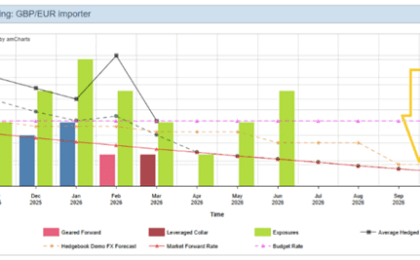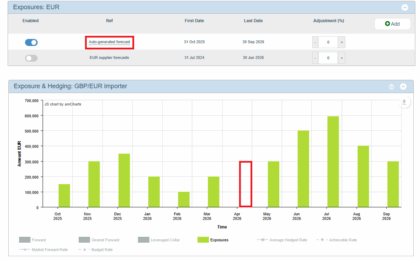Foreign exchange markets are unsettled. Exchange rates are shifting quickly. Liquidity can tighten with little notice, and corporate treasurers must respond with precision. In this environment, mark-to-market provides a clear and consistent measure of fair value. It helps identify exposures, anticipate liquidity needs, and meet reporting requirements under IFRS and US GAAP.
Mark-to-market is more than an accounting exercise. It is a practical tool for managing financial performance. It ensures transparency with boards and investors – and strengthens resilience in volatile markets. Businesses that apply this discipline are better positioned to respond quickly when conditions change. And isn’t that a position we all want to be in?
Defining Mark-to-Market (MtM) in FX
Mark-to-market is the process of revaluing financial instruments using current market data. In foreign exchange, this means revaluing forwards, swaps, or options based on spot rates, forward points, interest rate curves, and volatility levels. The outcome is an updated and objective fair value.
Accounting standards set the framework. IFRS and UK-adopted IFRS define fair value as the price that would be received to sell an asset or paid to transfer a liability between market participants at the measurement date (IFRS 13). US GAAP, under ASC 820, applies a similar framework with disclosure requirements for methods and inputs.
Australia and New Zealand use IFRS-aligned standards, ensuring comparability across markets. All require clear disclosure of valuation methods and classification between observable and unobservable inputs.
Why it Matters in time of FX Volatility
The importance of mark-to-market grows when currencies are volatile. Daily mark-to-market values drive margin calls under credit support annexes, and underestimating exposure can trigger sudden cash outflows. Counterparty and funding risk also increases. Large swings can also widen cross-currency basis spreads, signaling stress in funding markets and raising hedge costs.
Earnings are directly affected by mark-to-market. Fair value hedges send gains and losses to profit and loss, while cash flow hedges record the effective portion in other comprehensive income until the hedged item impacts results. Clear reporting on this ensures boards and investors understand financial performance. Governance also improves with disciplined mark-to-market practices, as standards require disclosure of inputs and sensitivities.
Instruments and Valuation Drivers
Each FX instrument has different mark-to-market drivers. FX forwards are valued using spot rates, forward points, and discount curves. Options are sensitive to spot, strike, time to expiry, and volatility; in stressed markets, volatility often dominates valuations.
Accounting Perspective: IFRS vs US GAAP
Hedge accounting determines where the results appear:
- In fair value hedges, mark-to-market changes in derivatives are recorded in profit and loss, with offsets in the hedged item.
- In cash flow hedges, the effective portion is recorded in other comprehensive income and released when the hedged transaction impacts results.
This treatment underscores the importance of precise valuation and documentation.
Ensuring Accurate Valuations
Several factors determine the accuracy of mark-to-market. A trusted data source and well understood calculation methodologies are critical to having confidence in mark-to-market.
Clear disclosures on valuation hierarchy and sensitivity analysis build confidence in reported results. They also strengthen compliance with IFRS and US GAAP, ensuring transparency for stakeholders.
What Good Practice Looks Like
Treasurers can strengthen governance by embedding consistent mark-to-market processes. Daily revaluation of hedges, supported by independent price verification and clear documentation, creates transparency.
Sensitivity and stress testing of volatility and funding shocks provide resilience. Monitoring hedge effectiveness helps identify potential issues early. Reporting aligned with IFRS and US GAAP ensures compliance and consistency.
Common Errors
Weaknesses in mark-to-market practice often include using the wrong discount curves, ignoring cross-currency basis spreads, and maintaining incomplete hedge accounting documentation. Underestimating liquidity needs for margin requirements is another frequent risk. Each of these can distort results and undermine financial stability.
Regional Considerations
Global principles apply across regions, but local frameworks influence practice.
- The United Kingdom uses UK-adopted IFRS and, as the world’s largest FX trading hub, relies on accurate reporting.
- The United States applies ASC 820 and ASC 815, with simplifications under ASU 2017-12.
- Australia and New Zealand use IFRS-aligned standards, with additional guidance from local regulators.
Practical Outcomes
Mark-to-market discipline helps businesses anticipate liquidity needs, maintain compliance, and deliver transparency to boards and investors. In times of FX uncertainty, consistent application of mark-to-market ensures exposures are measured correctly and risks are communicated clearly.
For treasurers and FX sales teams, it is a fundamental part of managing performance and meeting obligations in volatile markets.
It is also something Hedgebook is directly able to help you manage – we have a blog outlining five ways in which Hedgebook helps you manage MtM – or we can set up a quick call to show you.





